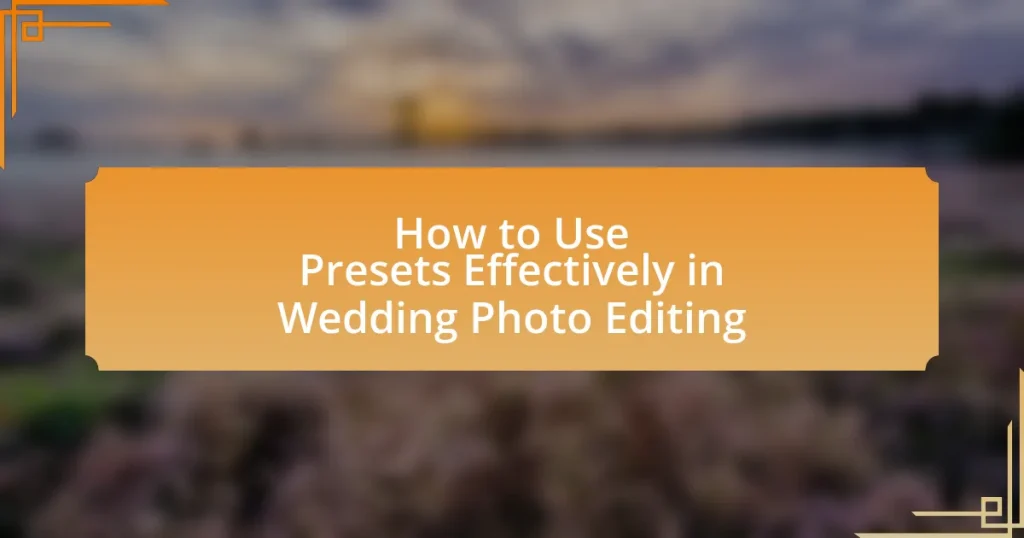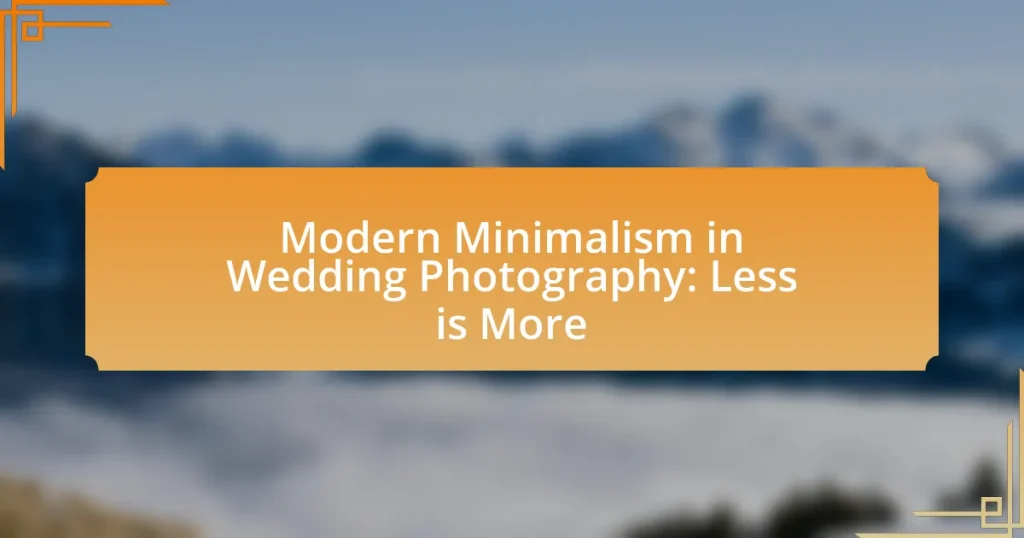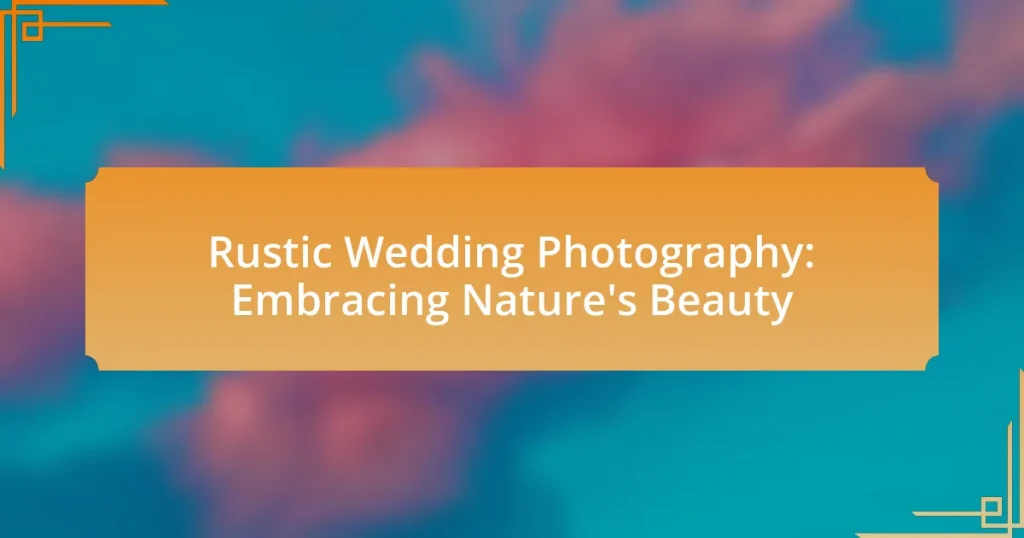Presets in wedding photo editing are pre-defined settings that streamline the editing process by adjusting exposure, contrast, color balance, and sharpness to achieve a desired aesthetic. This article explores the importance of presets in enhancing editing efficiency, maintaining consistency across wedding albums, and establishing a photographer’s brand identity. It covers the types of presets commonly used, factors to consider when selecting them, and best practices for their application. Additionally, it discusses how to customize presets for unique styles, avoid common mistakes, and maximize their effectiveness in wedding photography.
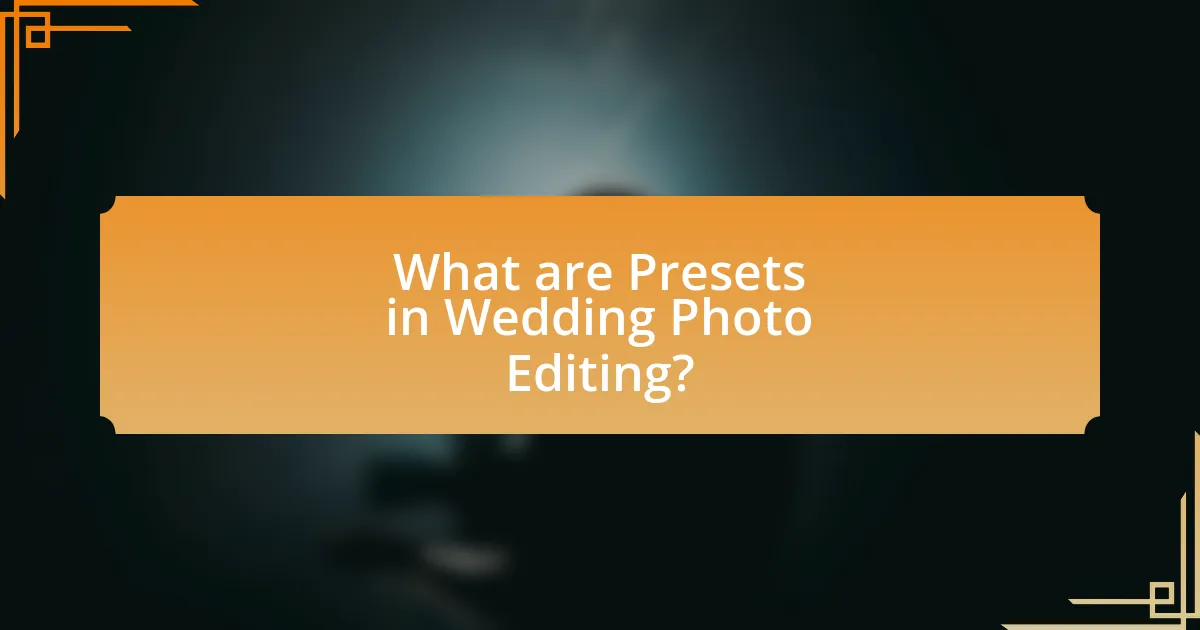
What are Presets in Wedding Photo Editing?
Presets in wedding photo editing are pre-defined settings that adjust various aspects of an image, such as exposure, contrast, color balance, and sharpness, to achieve a desired aesthetic. These tools streamline the editing process by allowing photographers to apply consistent styles across multiple images quickly, ensuring a cohesive look in wedding albums. The use of presets can significantly reduce editing time, as they eliminate the need for manual adjustments for each photo, which is particularly beneficial in high-volume scenarios like wedding photography.
How do presets enhance the editing process?
Presets enhance the editing process by providing a consistent starting point for adjustments, allowing photographers to apply specific styles or corrections quickly. This efficiency is crucial in wedding photo editing, where time is often limited and the volume of images can be high. By using presets, editors can maintain a cohesive look across a series of photos, ensuring that the final product reflects a unified aesthetic. Studies show that using presets can reduce editing time by up to 50%, enabling photographers to focus more on creative aspects rather than repetitive adjustments.
What types of presets are commonly used in wedding photography?
Commonly used presets in wedding photography include light and airy, moody, vintage, and black and white presets. Light and airy presets enhance brightness and soft tones, creating a romantic feel, while moody presets add depth with darker tones and contrast, suitable for dramatic scenes. Vintage presets emulate a nostalgic look with faded colors and film grain, appealing to couples seeking a timeless aesthetic. Black and white presets focus on contrast and texture, emphasizing emotions and moments without color distraction. These presets are popular because they streamline the editing process and help photographers maintain a consistent style throughout the wedding album.
How do presets save time for photographers?
Presets save time for photographers by allowing them to apply a consistent set of adjustments to multiple images simultaneously. This efficiency reduces the need for repetitive manual editing, enabling photographers to streamline their workflow. For instance, using presets can cut down editing time by up to 50%, as they automate processes like color correction, exposure adjustments, and contrast enhancement, which would otherwise require individual attention for each photo.
Why are presets important for wedding photo consistency?
Presets are important for wedding photo consistency because they ensure a uniform look across all images taken during the event. By applying the same preset to each photo, photographers can maintain consistent color grading, exposure, and tonal balance, which is crucial for creating a cohesive visual narrative. Studies show that consistent editing styles enhance viewer engagement and emotional connection, making the overall wedding album more appealing.
How do presets help maintain a cohesive style across a wedding album?
Presets help maintain a cohesive style across a wedding album by applying consistent color grading and tonal adjustments to all images. This uniformity ensures that photos taken in different lighting conditions or settings appear harmonious, enhancing the overall aesthetic of the album. For instance, using a specific preset can standardize the warmth, contrast, and saturation levels across various images, creating a seamless visual narrative. Studies in photography emphasize that cohesive editing contributes to a more professional look, making the album more appealing to viewers.
What role do presets play in brand identity for photographers?
Presets play a crucial role in establishing brand identity for photographers by providing a consistent visual style that reflects their unique artistic vision. This consistency helps photographers differentiate themselves in a competitive market, as clients can easily recognize their work through a signature look. For instance, a study by the American Society of Media Photographers highlights that 70% of clients prefer photographers whose style is easily identifiable, underscoring the importance of a cohesive aesthetic. By utilizing presets, photographers can streamline their editing process while ensuring that their images maintain a uniform appearance, reinforcing their brand identity across various platforms and client interactions.
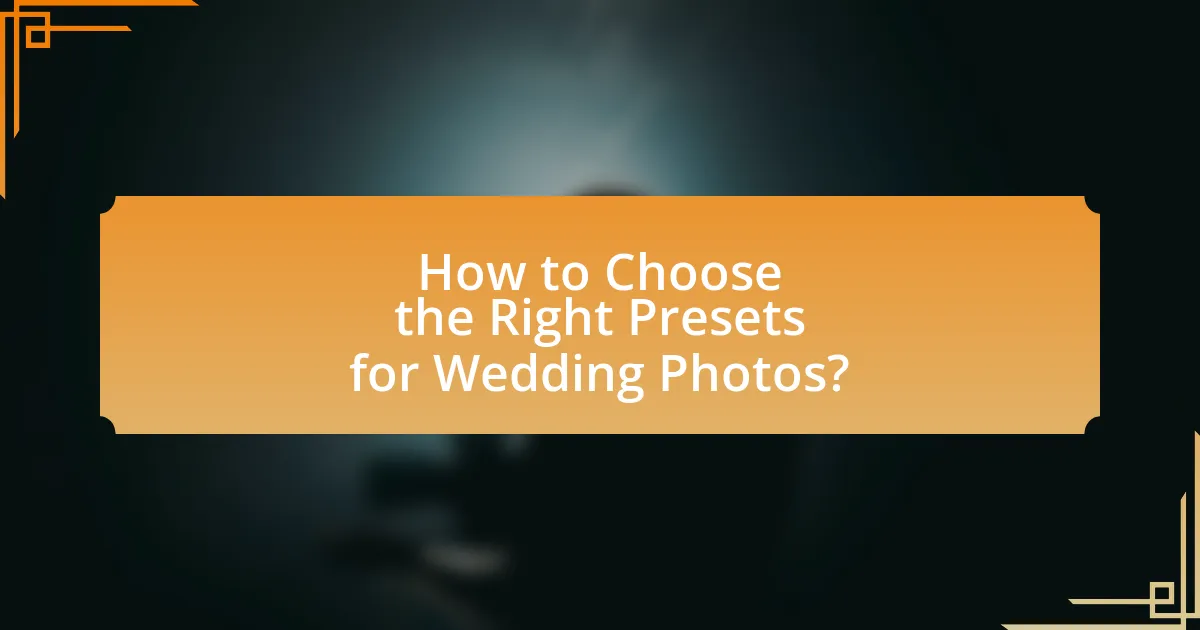
How to Choose the Right Presets for Wedding Photos?
To choose the right presets for wedding photos, first identify the desired mood and style that aligns with the couple’s vision. Selecting presets that enhance natural skin tones and complement the wedding’s color palette is crucial. For instance, warm presets can evoke a romantic atmosphere, while cooler tones may suit a modern aesthetic. Additionally, consider the lighting conditions of the venue; presets designed for low-light situations can improve image quality in dim environments. Research shows that consistent editing styles can enhance the overall storytelling of wedding albums, making it essential to choose presets that maintain a cohesive look throughout the collection.
What factors should be considered when selecting presets?
When selecting presets for wedding photo editing, consider the style, lighting conditions, and the emotional tone you wish to convey. The style of the preset should align with the overall aesthetic of the wedding, whether it be vintage, modern, or vibrant. Lighting conditions, such as whether the photos were taken indoors or outdoors, can significantly affect how a preset appears; thus, choose presets that complement the specific lighting scenario. Additionally, the emotional tone, which can range from romantic to playful, should guide your selection to ensure that the final images resonate with the couple’s vision. These factors are crucial as they directly influence the cohesiveness and impact of the final photo collection.
How does the wedding theme influence preset selection?
The wedding theme significantly influences preset selection by dictating the overall mood, color palette, and style of the photographs. For instance, a rustic wedding theme may lead to the selection of presets that enhance warm tones and earthy colors, while a modern, minimalist theme might favor presets that emphasize clean lines and cooler hues. This alignment ensures that the final images resonate with the couple’s vision and the atmosphere of the event, creating a cohesive visual narrative. Studies in photography aesthetics indicate that color harmony and thematic consistency are crucial for impactful imagery, reinforcing the importance of matching presets to the wedding theme.
What should photographers look for in quality presets?
Photographers should look for presets that enhance image quality while maintaining a natural appearance. Quality presets should offer consistent color grading, proper exposure adjustments, and compatibility with various lighting conditions. Additionally, they should be customizable to suit individual styles and preferences, allowing for flexibility in editing. Research indicates that presets that are well-designed can significantly reduce editing time while improving the overall aesthetic of wedding photographs, making them a valuable tool for photographers.
How can photographers customize presets for their unique style?
Photographers can customize presets for their unique style by adjusting parameters such as exposure, contrast, saturation, and color balance within their editing software. This customization allows photographers to create a signature look that reflects their artistic vision. For instance, a photographer may increase the warmth in their presets to achieve a more inviting tone, or they might decrease saturation for a more muted, vintage feel. By saving these adjustments as new presets, photographers can streamline their workflow while maintaining consistency across their work.
What adjustments can be made to enhance preset effectiveness?
To enhance preset effectiveness in wedding photo editing, photographers can adjust exposure, contrast, and color balance. These adjustments allow for fine-tuning the preset to match the specific lighting conditions and mood of the wedding. For instance, increasing exposure can brighten underexposed images, while adjusting contrast can add depth and dimension. Additionally, modifying color balance ensures that skin tones appear natural and consistent across different lighting scenarios. Research indicates that tailored adjustments can improve the overall aesthetic quality of images, leading to higher client satisfaction.
How do photographers balance preset use with personal editing techniques?
Photographers balance preset use with personal editing techniques by integrating presets as a foundational starting point while applying individual adjustments to achieve a unique style. This approach allows photographers to save time during the editing process, as presets can quickly enhance colors and tones, while personal techniques enable them to fine-tune images to reflect their artistic vision. For instance, a photographer might use a preset for overall color grading but adjust exposure, contrast, and specific color hues to match the mood of the wedding. This method ensures that the final images maintain a consistent aesthetic while also showcasing the photographer’s distinct style, which is crucial in wedding photography where personalization is key.
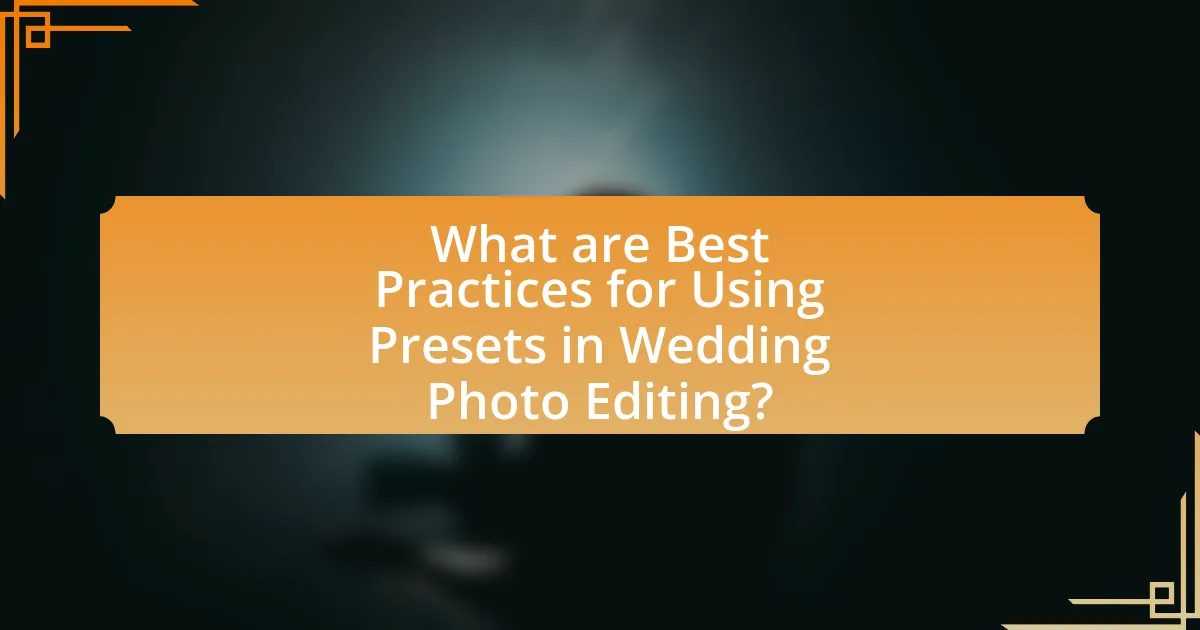
What are Best Practices for Using Presets in Wedding Photo Editing?
Best practices for using presets in wedding photo editing include customizing presets to fit the specific lighting and color conditions of each wedding, applying them selectively rather than universally, and maintaining a consistent style throughout the album. Customization ensures that the unique elements of each wedding are highlighted, while selective application allows for adjustments based on individual images. Consistency across the album is crucial for creating a cohesive narrative, which is supported by the fact that a uniform editing style enhances the overall aesthetic appeal of wedding photography.
How can presets be effectively applied during the editing workflow?
Presets can be effectively applied during the editing workflow by integrating them at various stages to enhance efficiency and maintain consistency. Utilizing presets at the beginning of the editing process allows for a uniform base across all images, ensuring that the overall aesthetic aligns with the desired style. For instance, applying a color grading preset can establish a cohesive look that reflects the wedding’s theme. Additionally, fine-tuning individual images after applying presets can address specific lighting or color issues, allowing for personalized adjustments while retaining the foundational style. This method not only saves time but also leverages the strengths of presets to streamline the editing process, resulting in a polished final product.
What steps should be taken before applying presets to images?
Before applying presets to images, it is essential to evaluate the images for exposure, color balance, and overall composition. This evaluation ensures that the images are in a suitable state for the presets to enhance their quality rather than detract from it. Additionally, it is important to consider the specific style and mood desired for the final images, as different presets can significantly alter the visual outcome. By assessing these factors, photographers can select the most appropriate presets that align with their artistic vision and the wedding’s theme.
How can batch processing improve efficiency when using presets?
Batch processing can significantly improve efficiency when using presets by allowing multiple images to be edited simultaneously with the same settings. This method reduces the time spent on repetitive tasks, as adjustments made to one image can be automatically applied to a batch of photos, streamlining the workflow. For instance, in wedding photo editing, applying a preset to a group of images taken in similar lighting conditions can enhance consistency and save hours compared to editing each photo individually. Studies show that batch processing can cut editing time by up to 50%, making it a valuable technique for photographers managing large volumes of images.
What common mistakes should be avoided when using presets?
Common mistakes to avoid when using presets include applying them without adjusting for individual images, relying solely on presets without understanding their settings, and neglecting to consider the lighting and color conditions of the original photo. Applying presets indiscriminately can lead to inconsistent results, as each image may require unique tweaks to achieve the desired effect. Additionally, using presets without knowledge of their parameters can result in over-processing or unnatural appearances. Finally, failing to account for the specific lighting and color context can diminish the quality of the final edit, as presets are often designed with certain conditions in mind.
How can over-reliance on presets negatively impact photo quality?
Over-reliance on presets can negatively impact photo quality by limiting the photographer’s ability to make nuanced adjustments tailored to specific lighting conditions and subjects. When photographers depend heavily on presets, they may overlook unique elements in each scene that require individualized editing, leading to a homogenized look across their portfolio. This lack of customization can result in images that appear flat or unoriginal, as the same preset applied to different photos may not account for variations in exposure, color balance, or contrast. Furthermore, studies have shown that images edited with a one-size-fits-all approach often fail to engage viewers, as they lack the emotional depth and storytelling that personalized editing can provide.
What are the signs that a preset is not suitable for a particular image?
A preset is not suitable for a particular image if it results in unnatural colors, excessive contrast, or loss of detail. Unnatural colors occur when the preset alters the image’s hues in a way that does not reflect reality, such as skin tones appearing overly orange or green. Excessive contrast can lead to loss of detail in highlights and shadows, making the image look flat or overly dramatic. Additionally, if the preset introduces unwanted artifacts or noise, it indicates incompatibility with the image. These signs demonstrate that the preset fails to enhance the image effectively, compromising its overall quality.
What tips can help photographers maximize the use of presets?
Photographers can maximize the use of presets by customizing them to fit their unique style and the specific lighting conditions of each shoot. Customization allows photographers to adjust settings such as exposure, contrast, and color balance, ensuring that the preset enhances the image rather than detracts from it. Additionally, photographers should organize their presets into categories based on style or mood, which streamlines the editing process and makes it easier to find the right preset for a particular image. Regularly updating and refining presets based on feedback and new techniques also helps maintain their effectiveness. Studies show that personalized editing workflows can significantly reduce editing time while improving overall image quality, making these strategies essential for efficient wedding photo editing.
How can photographers create their own presets for personalized editing?
Photographers can create their own presets for personalized editing by adjusting settings such as exposure, contrast, saturation, and color balance in their editing software, then saving these adjustments as a preset. This process allows photographers to maintain a consistent style across their work, particularly in wedding photo editing, where a cohesive aesthetic is essential. For example, in Adobe Lightroom, photographers can create a preset by making desired adjustments to a photo, then selecting “Create Preset” from the Presets panel, naming it, and saving it for future use. This method is validated by the widespread use of presets in professional photography, as they streamline the editing process and enhance workflow efficiency.
What resources are available for finding high-quality wedding presets?
High-quality wedding presets can be found through several key resources. Online marketplaces such as Etsy and Creative Market offer a wide range of presets created by professional photographers, allowing users to browse and purchase tailored options. Additionally, photography blogs and websites like Lightroom Presets and Presetpro provide curated collections and reviews of popular presets, ensuring quality and effectiveness. Social media platforms, particularly Instagram and Pinterest, also serve as valuable resources where photographers share their presets and editing styles, often linking to purchase options. These platforms collectively provide access to a diverse selection of high-quality wedding presets suitable for various editing styles.
